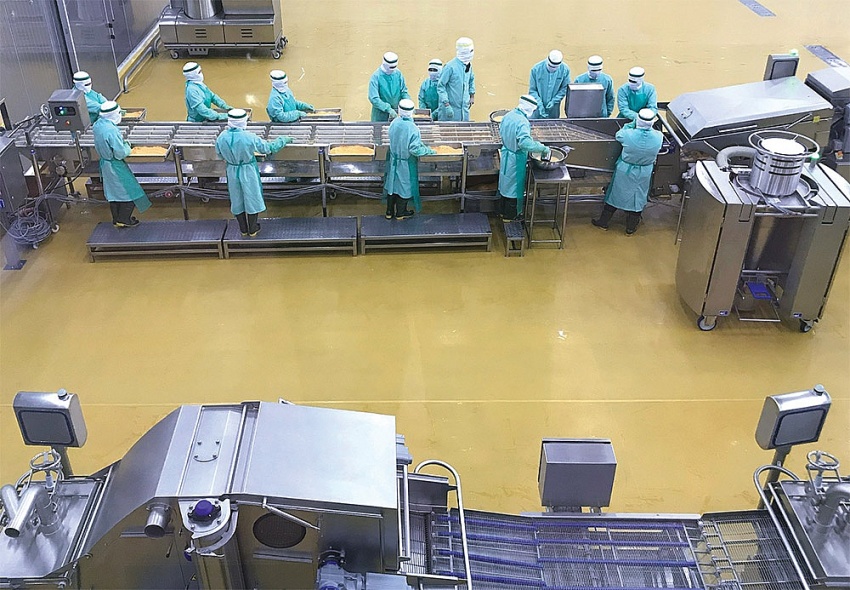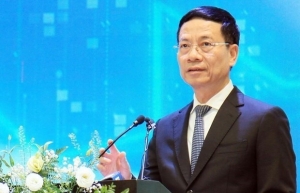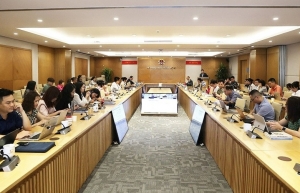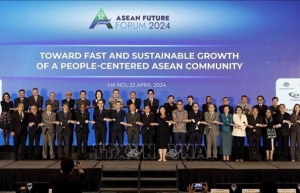ASEAN encouraged to embrace global flows
Brian McFeeters, senior vice president and regional managing director of the US-ASEAN Business Council, said that in the context that global investment flows are changing significantly, investors are seeking stable destinations.
“ASEAN is on the radar of many US companies for their investment,” McFeeters told a plenary session within the ASEAN Future Forum (AFF) held last week in Hanoi. “It is estimated that more than $360 billion has been put into the bloc by US investors so far.”
In ASEAN, Vietnam is one of the more attractive markets, where US companies have funded export-oriented sectors and then export goods back to the US, McFeeters added.
According to Vietnam’s Ministry of Planning and Investment, cumulatively as of March 20, the US was Vietnam’s 11th largest foreign investor with total registered capital of over $11.83 billion for over 1,350 valid projects.
Currently, the US is among the key export markets of Vietnam. Two-way trade between both countries soared from $450 million in 1995 when the two countries established their diplomatic relations, to $110.6 billion last year. The figure hit $29.7 billion in the first three months of 2024, up from $23.7 billion recorded in the same period last year.
 |
| ASEAN encouraged to embrace global flows |
The US Export-Import Bank and Vietnam Development Bank recently signed a $500 million MoU to support US export financing to advance Vietnam’s green economy transition, infrastructure projects, and climate-related projects. However, McFeeters underlined that US investment into ASEAN should have been higher if investors had not faced some hurdles in applying digital solutions.
“Many cumbersome procedures remain and we want ASEAN to go digital more quickly,” he said. “For example, many small- and medium-sized enterprises (SMEs) are facing great difficulties with data storage as they are cash-strapped. Currently, a shared cross-border database is not applied in the region. If we have one, it will make it more favourable for investors.”
ASEAN leaders recently highlighted the ever increasingly pivotal role of digital technology in achieving an innovative, inclusive, resilient, and sustainable economic growth in the region. Negotiations on the ASEAN Digital Economy Framework Agreement are expected to be completed at the end of 2025, making it favourable to enterprises to perform with shared digital platforms.
It was reported at the AFF that revenues from the digital economy last year in ASEAN are estimated to have reached $100 billion, up by eight times from 2016. The figure is expected to hit over $1 trillion in 2030.
This year, under the chairmanship of Laos, ASEAN member states have committed to build the bloc into a more competitive investment environment, with Vietnam saying it will make bigger efforts to lure in more funding from the bloc and its partner countries.
ASEAN ministers last month introduced 14 priority economic deliverables in various sectors, embracing agriculture, tourism, energy, intellectual property, digital transformation, SMEs, and others, as well as initiatives to strengthen supply chain and narrow the development gap among ASEAN member states.
For trade, the ministers have agreed to further opening markets to ensure food security and strengthen the resilience and sustainability of the regional supply chain; not using new non-tariff measures; building up foundations for intra-bloc trade facilitation to support supply chain connectivity; and utilising digital technology and commerce to support businesses.
Oh Young Ju, Minister of SMEs and Startups in South Korea and former South Korean Ambassador to Vietnam, told the AFF that the South Korean government is considering various programmes to help this nation’s companies to cooperate with businesses in Southeast Asia.
“This is aimed to creating effective supply chains for enterprises who can contribute to the region’s economic development. The South Korean government also commits to facilitate all ASEAN businesses to participate in supply chains of South Korean enterprises,” Ju said.
ASEAN leaders have tasked economic ministers to future-proof the ASEAN Economic Community including through enhancing policies, strengthening protection, as well as ensuring transparency and certainty of relevant laws and regulations, and promoting convergence in competition policy while still considering each member state’s sensitivities and levels of development to attract quality and sustainable funding.
At the end of 2022, regional member states also agreed that they should adopt a holistic approach to building a competitive facilitation climate, which will allow them to lure in more foreign direct investment within the bloc and from its five partners of China, Japan, South Korea, Australia, and New Zealand.
“To keep ASEAN as a centre of economic growth, it must boost its economic links, expand intra-bloc markets and unleash trade and investment flows,” stated Vietnam’s PM Pham Minh Chinh. “Member states need to remove obstructions on policies and institutions, while stably keeping intra-bloc supply chains in order to improve the region’s resilience against global challenges.”
It should also focus on reviewing and upgrading existing free trade agreements and negotiating new ones between ASEAN and its partners so as to create new momentum for economic development, the PM added.
 | ASEAN Future Forum 2024 enters first session The first session of the ASEAN Future Forum 2024 (AFF 2024) in Hanoi on April 23 focused on fast and sustainable growth for the Association of Southeast Asian Nations (ASEAN). |
 | Ministry provides media training on global integration The Ministry of Information and Communications (MIC) held a workshop on April 25 to provide media training on global integration, UNESCO, and ASEAN for reporters and editors from press agencies in Hanoi. |
 | UK supports ASEAN’s economic integration The UK delegation to ASEAN held a seminar in Jakarta, Indonesia on April 24 to discuss the ASEAN-UK economic integration programme. |
 | ASEAN Future Forum 2024 wraps up in Hanoi The ASEAN Future Forum 2024 (AFF 2024) wrapped up in Hanoi on April 23 after a day of productive discussions. |
What the stars mean:
★ Poor ★ ★ Promising ★★★ Good ★★★★ Very good ★★★★★ Exceptional
 Tag:
Tag:
Related Contents
Latest News
More News
- Global partnerships key to Vietnam’s IFC development (December 26, 2025 | 16:18)
- Vingroup pulls out of bid to invest in North-South high-speed railway (December 26, 2025 | 11:42)
- Strengthening supply chains through trade promotions and customs reform (December 24, 2025 | 14:00)
- PM orders investment model for North–South high-speed rail (December 22, 2025 | 17:43)
- LS Eco Energy to invest in Vietnam rare earth sector (December 22, 2025 | 17:31)
- Government moves to establish International Financial Centre (December 21, 2025 | 21:00)
- Vietnam's IFC to target global investment flows (December 21, 2025 | 18:00)
- Two national hospitals expand capacity with new facilities (December 20, 2025 | 09:00)
- Ha Tinh breaks ground on major Vingroup industrial and energy projects (December 19, 2025 | 18:24)
- EVN launches major power infrastructure projects nationwide (December 19, 2025 | 18:17)























 Mobile Version
Mobile Version